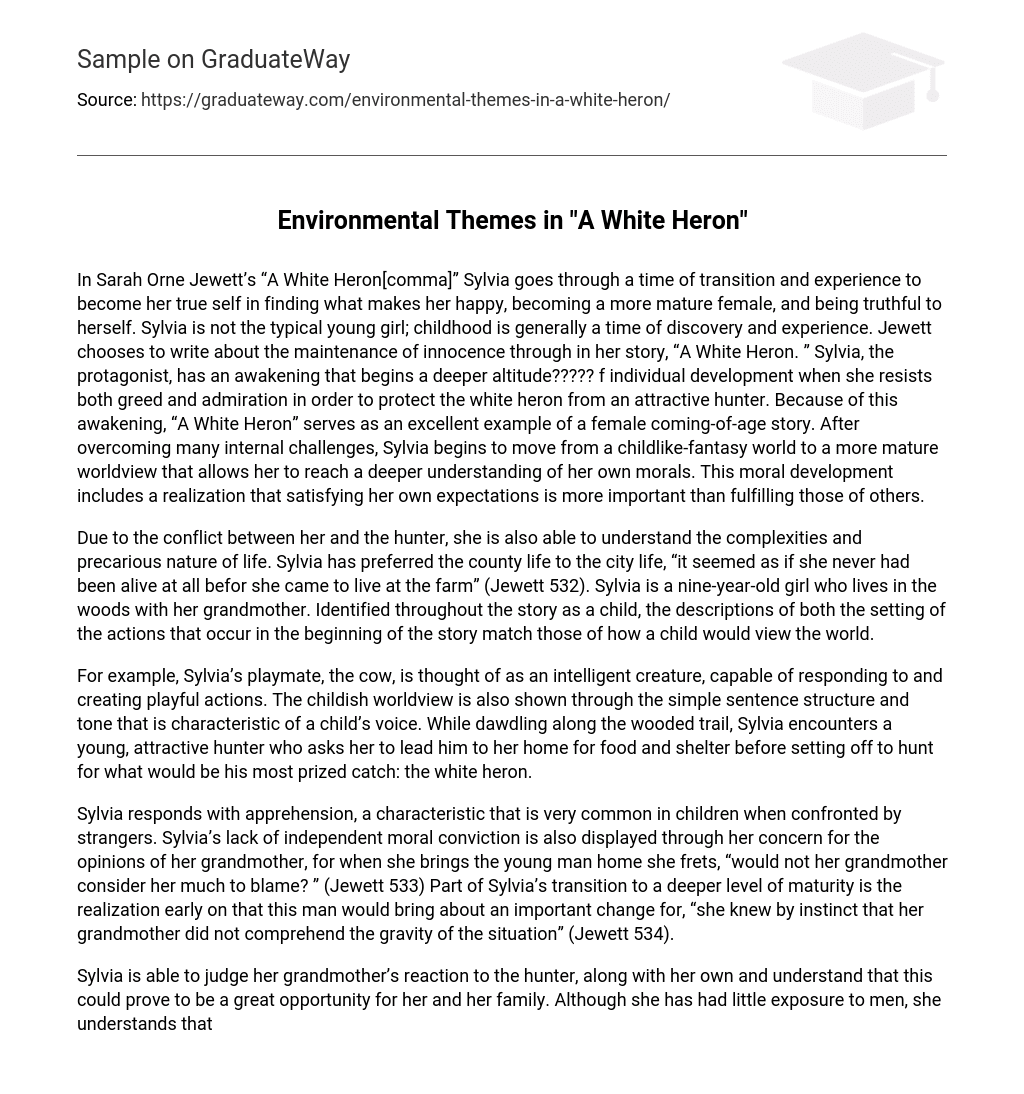In Sarah Orne Jewett’s “A White Heron,” Sylvia undergoes a period of transition and growth as she discovers her true self, finds happiness, matures as a female, and stays true to herself. Sylvia is not your typical young girl; childhood is typically a time for exploration and learning. However, Jewett focuses on the preservation of innocence in her story, “A White Heron.” Sylvia, the main character, experiences an awakening that marks a significant stage in her personal development as she resists both greed and admiration to protect the white heron from a charming hunter. This awakening makes “A White Heron” an excellent example of a coming-of-age story for females. Overcoming internal obstacles, Sylvia gradually shifts from a childlike fantasy world to a more mature perspective that grants her a profound understanding of her own moral principles. This moral development includes realizing that meeting her own expectations is more important than meeting the expectations of others.
Due to her conflict with the hunter, Sylvia gains insight into the intricacies and uncertainty of life. The protagonist, a nine-year-old girl named Sylvia, chooses rural living over city life. As stated in the story, “it seemed as if she never had been alive at all before she came to live at the farm” (Jewett 532). Sylvia resides in the forest with her grandmother. The narrative consistently emphasizes her youth and portrays the initial events through a child’s perspective.
The text demonstrates Sylvia’s perception of animals and her naive perspective using simple sentences and tone typical of a child’s voice. As Sylvia walks through the forest, she meets a charming hunter who requests her help in finding food and shelter before embarking on a quest for his ultimate trophy: the white heron.
Sylvia’s response to the young man is filled with apprehension, a common characteristic seen in children when faced with strangers. Her lack of independent moral conviction is also evident as she worries about what her grandmother will think when she brings the young man home, wondering if her grandmother will consider her at fault. This shows that Sylvia values the opinions of others over her own. As Sylvia goes through her transition into a deeper level of maturity, she realizes early on that this man will bring about an important change. She instinctively knows that her grandmother doesn’t fully grasp the seriousness of the situation.
Sylvia has the ability to evaluate both her grandmother’s and her own reactions to the hunter. She recognizes that this situation could benefit her and her family. Despite having limited experience with men, Sylvia knows that success for women in that time is not based on their moral beliefs but rather on how well they conform to men’s desires. However, as Sylvia develops a stronger sense of ethics and justice, she finds herself conflicted between complying with the hunter’s wishes and following her own principles.
Sylvia is transitioning into adulthood, as evidenced by her stepping away from her childhood. The hunter demonstrates kindness and charm, especially when he promises Sylvia ten dollars as a reward for information about the white heron’s whereabouts. This offer also sparks feelings of attraction within Sylvia, as her dormant womanly heart is tantalized by a dream of love (Jewett 535).
A young Sylvia, who still possesses childlike qualities, chooses to cling to a fantasy where she believes the hunter will fall in love with her, rather than facing the harsh reality that he is only using her to locate a valuable prize. Due to her undeveloped moral compass at this stage of the narrative, Sylvia decides to disregard her natural affection for nature and living creatures. She falls under the hunter’s spell, enticed by his promise of wealth, and ultimately agrees to reveal the location of the heron’s nest.
Sylvia must be honest with herself and follow her own convictions. Her decision to search for the heron’s nesting place leads to a transformative experience when she scales a towering pine tree. This momentous climb marks the beginning of Sylvia’s journey towards a deeper sense of right and wrong and a stronger sense of self. The significance lies in the fact that Sylvia has never had the courage to attempt such a feat in the past. Symbolically, each branch she reaches represents a new stage of development in her moral compass and personal beliefs.
Sylvia embarks on this adventure on her own, without anyone knowing or giving their approval. This demonstrates her shift from being dependent on others to becoming a more self-sufficient adult. Despite the dangers involved in climbing the tree, Sylvia is rewarded with a breathtaking view of the world and the majestic white heron. The passage also includes vivid imagery that symbolizes Sylvia’s rebirth. The age of nine holds significance as it represents the nine months spent in the womb, serving as a universal symbol for new beginnings.
The image of the white heron emerging from a dead hemlock in Jewett’s story symbolizes purity, the flight of new ideas, and rebirth. Jewett describes how Sylvia feels like she could fly away among the clouds, indicating a new perspective on the world. This newfound view helps Sylvia appreciate the value and complexity of all life and highlights the difficulty of human and nature coexisting. Overall, childhood is a time of transition and experience.
By gaining experience, children become wise and knowledgeable about the functioning of the world and their place within it. Sylvia’s encounter with the white heron provides insight into her position in the natural and human realms, as well as the internal conflict that desires can create. Remarkably, she handles this challenge with maturity and sensibility, despite her young age. Her moral awakening forms the foundation of this tale of initiation, as it is closely linked to her longing to preserve her innocence. This innocence enables her to appreciate her deep affinity for nature.





